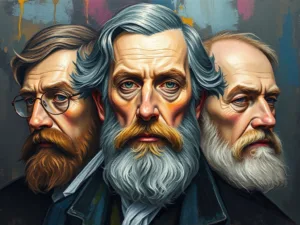Understanding Three Modes of Faith
Introduction to Žižek on Religion
Žižek on Religion focuses on his masterful work, The Puppet and the Dwarf provides a provocative lens to examine religion, its structures, and its philosophical implications. Žižek categorizes religion into three modes: People’s Religion, Positive Religion, and Religion of Reason. These categories illuminate how faith manifests in societies and shapes human behavior. To deepen understanding, it’s crucial to explore Žižek’s metaphors of the puppet and the dwarf, which anchor his critique of belief systems.
People’s Religion: The Puppet of Everyday Life
People’s Religion arises from localized, grassroots faith practices tied to culture and tradition. It.

For example, in many parts of Africa, Christianity integrates ancestral veneration, creating hybrid forms of worship. This mode’s strength lies in its accessibility and its ability to foster community bonds.
However, Žižek views People’s Religion as a puppet controlled by unseen forces. These forces include historical power structures and ideological manipulation. For instance, during colonialism, missionaries often used Christianity to justify subjugation while claiming to “uplift” native populations. In Žižek’s terms, the puppet is religion’s surface—a comforting figure animated by deeper ideological systems that perpetuate hierarchy and control.
Žižek on Religion: Positive Religion as the Dwarf
Positive Religion represents institutionalized faith, where doctrines and authorities define belief systems. This includes Catholicism, Islam, and other organized religions with established hierarchies and theological frameworks. Positive Religion offers stability and coherence, often serving as a moral compass during societal turmoil.

Žižek, however, introduces the concept of the dwarf to critique Positive Religion’s hidden dynamics. Borrowing from Hegel, Žižek compares the dwarf to a manipulative trickster who operates the puppet from within. Institutions present an appearance of divine authority, but their primary aim is to maintain control. For example, the medieval Catholic Church amassed wealth and influence through indulgences, masking greed with theological justification.
Positive Religion’s strength lies in its capacity to mobilize large-scale social movements. Martin Luther King Jr.’s use of Christian teachings to advance civil rights is a notable example. Yet Žižek warns of its susceptibility to corruption and dogmatism, which can suppress dissent and intellectual inquiry.
Religion of Reason: The Puppet Without a Dwarf
Religion of Reason prioritizes ethical principles and rationality over supernatural beliefs. Enlightenment thinkers like Immanuel Kant advocated for this approach, seeking a universal moral law grounded in reason rather than revelation. Religion of Reason appeals to those

who reject dogma but still value the ethical underpinnings of faith.
Žižek sees this mode as a puppet without a dwarf—an idealistic yet incomplete vision. While it frees individuals from institutional control, it often lacks the emotional and communal depth that other modes provide. For example, secular humanism emphasizes shared values but struggles to inspire devotion or solidarity among large groups. Žižek argues that the absence of the dwarf (hidden ideological force) creates an illusion of autonomy, ignoring the persistence of systemic power structures.
The Puppet and the Dwarf: A Metaphor for Faith and Ideology
Žižek’s title metaphor encapsulates his view of religion as a dual phenomenon. The puppet represents religion’s visible aspects—rituals, doctrines, and symbols. The dwarf signifies the hidden ideological mechanisms that sustain these practices. Together, they reveal religion’s ability to both empower and manipulate.
Žižek draws inspiration from the Jewish folktale of the Golem, a clay figure animated by mystical forces. In The Puppet and the Dwarf, he adapts this idea to critique the interplay between faith and ideology. Religion, for Žižek, is never neutral; it always serves a deeper purpose, whether to inspire hope or reinforce power dynamics.
Critical Assessment of Žižek’s Views
Žižek’s framework challenges readers to rethink religion’s societal role. Critics argue that his analysis overemphasizes ideology, neglecting religion’s spiritual and emotional dimensions. For instance, feminist theologians highlight how grassroots religious movements empower marginalized groups, countering Žižek’s view of People’s Religion as merely ideological.
Supporters, however, praise Žižek for exposing religion’s complicity in maintaining power structures. His critique encourages believers and non-believers alike to question the forces that shape their values and practices.
Pragmatic Implications
Žižek’s insights have practical applications. Understanding the puppet-dwarf dynamic helps religious leaders balance tradition with reform. For instance, Catholic priests advocating for liberation theology in Latin America embody a progressive form of Positive Religion. Similarly, secular policymakers can draw from Religion of Reason to promote ethical governance while respecting diverse beliefs.
Žižek’s exploration of religion challenges simplistic views, encouraging nuanced reflection on faith’s capacity to inspire, control, and transform. His work offers a vital tool for understanding how religion operates in both personal and societal contexts.
Sources Cited
Žižek, S. (2003). The Puppet and the Dwarf: The Perverse Core of Christianity. MIT Press.
Hegel, G. W. F. (1977). Phenomenology of Spirit. Oxford University Press.
King, M. L. Jr. (1963). Letter from Birmingham Jail.
Suggestions for Further Reading
Eagleton, T. (2009). Reason, Faith, and Revolution. Examines the cultural value of religion in secular societies.
Taylor, C. (2007). A Secular Age. Investigates the transformation of religion in modernity.
Žižek, S. (2012). Less Than Nothing. Explores the relationship between ideology and belief.
Ricoeur, P. (1995). Figuring the Sacred. Analyzes the symbolic aspects of faith.
Kant, I. (1998). Religion Within the Boundaries of Mere Reason. Explores the ethical foundations of religion.
Habermas, J. (2008). Between Naturalism and Religion. Discusses tensions between faith and rationality.
Asad, T. (1993). Genealogies of Religion. Examines religion’s role in cultural formation.
Butler, J. (2004). Precarious Life. Explores vulnerability and ethics in religious contexts.
Levinas, E. (1969). Totality and Infinity. Discusses ethical responsibility in religious thought.
Disclaimer: The images and videos in this post are AI-generated creations, intended purely for illustrative and conceptual purposes. They are not real-life representations and should not be interpreted as such. Their sole purpose is to offer a visual means of exploring the topics discussed in this post.




